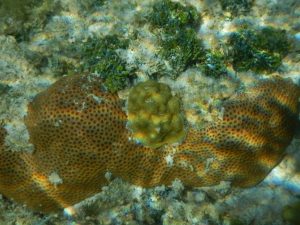This morning, we started the day off right with plates of fat banana and pineapple pancakes. I’m beginning to think that my life is actually a dream, at least for the time being.
We spent the morning analyzing data we collected in the previous two days about live hard corals and sea urchins. We used coral cover and sea urchin diversity and size as measures of overall reef health, and we wanted to see whether the Marine Protected Areas implemented by the Belizean government are actually improving reef health. After analyzing our data, we decided that we couldn’t solidly conclude anything about the effectiveness of MPAs. We’d have to conduct further studies before we can make a real statement about MPAs.
After lunch came the exciting part. We waded out to the shallow reefs behind the island to look for critters in the sea grass and coral rubble! When we first waded out to sea, the ground was nothing but a sludge of mud and rotting seaweed. It was, like, reaaaal nasty. The water was so hot, too! Like a bathtub, except crusted with algae and stinking of fish.
Once we’d waded out a little, the water became much cooler and clearer. It became deep enough to swim and search for critters in the sea grass. My first find of the day was a donkey dung sea cucmber (yes, that’s its real name!) that was about 35 cm long. It literally looks like a gigantic, brown donkey turd, except it has tube feet and a red belly. I dumped that guy into our sea collection bucket that we later took back to the island to examine.It was a fun afternoon filled with much turning over of rocks and investigating the benthos for crustaceans, brittle stars, and fish.
Today was another great day for Echinoderms. I found that many brittle stars, especially spiny ophiocomas, love to hide under algae-encrusted pieces of coral rock. Once I lifted up the rubble, I’d often see one or two spiny brown and white-banded arms disappearing around the bend.
 Spiny ophiocoma brittle star.
Spiny ophiocoma brittle star.
I snatched 5 to put in our collection bucket before they disappeared. Two were quite large, maybe 10 cm from arm tip to tip, but one was teensy! It was 2 cm from tip to tip. Ceyda also found a smaller donkey dung sea cucumber lounging in the sea grass, and Elena found a slate pencil urchin to add to my collection.
Fun fact: sea cucumbers make great water guns! When submerged, they fill themselves up with water. You can pick them up and gently squeeze to make them shoot the water out at anyone who crosses your path! Scott used one of the donkey dung cucumbers to squirt me with water, so naturally, I had to get him back. Again, clearly, this was all in the name of science.
 Here I am holding the larger of the donkey dung sea cucumbers that we found.
Here I am holding the larger of the donkey dung sea cucumbers that we found.
Other cool spots and catches of the day included a large nurse shark, a gigantic spiny lobster (and 3 smaller ones), a cocoa damsel fish, and a baby Caribbean reef octopus!! We spotted the nurse shark swimming in the shallows near the reef crest, and I scooped up the bright yellow damsel fish in the old conch shell that it lived in. Bonus: that same conch shell also turned out to be home to the octopus, which was a super cool find!
Everyone’s favorite was the octopus, which Jessica christened Herbert. He was small enough to fit in the palm of a hand and changed colors very frequently. I think we stressed him out though, because he inked in the tray we held him in 🙁

Herbert the Caribbean reef octopus.
I was shocked by the sheer diversity and amount of animals we could find here just by wading out behind the island. It’s truly incredible – I didn’t even begin to detail all of the organisms we found today. If I did, I’d be writing for 20 pages.
I can’t believe that we only have two more full days in this idyllic place. I don’t want to think about leaving, but for now, I’m going to enjoy learning about this ecosystem to the fullest!




















 Spiny ophiocoma brittle star.
Spiny ophiocoma brittle star. Here I am holding the larger of the donkey dung sea cucumbers that we found.
Here I am holding the larger of the donkey dung sea cucumbers that we found. 